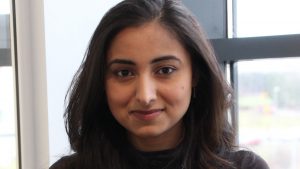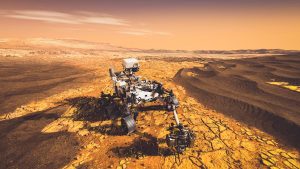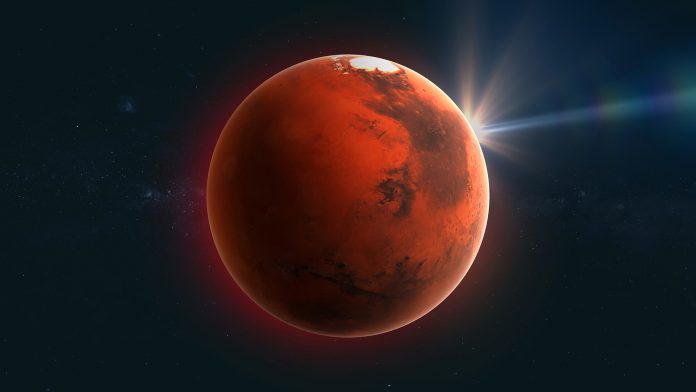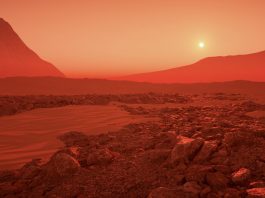Dr Rain Irshad, Autonomous Systems Lead at RAL Space, discusses what Europe’s first analysis facility for extra-terrestrial samples could tell us about Mars.
Understanding more about the prospect of life on Mars could soon be a reality, as the UK has recently been granted funding to design Europe’s first facility for the analysis of extra-terrestrial samples.
The UK Space Agency has funded the Science and Technology Facilities Council’s RAL Space in Oxfordshire to conduct an architectural feasibility study for the construction of a specialist facility for the preparation, characterisation, and analysis of extra-terrestrial samples.
RAL Space will produce the study for a new 2,400m2 Curation and Analysis Facility for Extra-terrestrial Samples as part of its proposal for building the facility in the UK.
The facility will enable the analysis of extra-terrestrial samples returned from various missions, including from asteroids and Mars. The Mars Sample Return mission, jointly organised by NASA and the European Space Agency (ESA), is set to bring samples back to Earth by 2030, so an analysis facility must be operational shortly after this.
The possibilities that this facility could bring are of particular magnitude to Dr Rain Irshad, Autonomous Systems Lead at RAL Space, who has been involved with the sample return project for around eight years. Dr Irshad has held a passion for space discovery from a very young age and says that the idea of bringing back a piece of another world is huge for her.

Georgie Whitworth, Editor of The Innovation Platform, spoke to Dr Irshad to find out the potential that this facility holds for space exploration and discovery.
Can you briefly explain more about RAL Space as an organisation and your role there?
I am a physicist and systems engineer, responsible for the smooth-running of missions. I have developed a specialism in Mars instruments and I was the RAL Space lead on the Seismic Experiment for the Interior Structures – Short Period Sensors (SEIS-SP) instrument on the geological InSight mission to Mars, which is looking at Mars quakes. I am also the Autonomous Systems Lead at RAL Space, where I am involved in the robotics work. One of my other interests is in terrestrial applications of space technology and I developed a project using some of the rovers we created to test technology for Mars exploration.
The work at RAL Space covers an expansive range of specialisms and we are currently moving into a new era. Alongside sample return and Mars exploration, we are also focusing on lunar exploration and prospecting. In addition, we have been building the National Satellite Test Facility, which is a first for the UK, designed to test whole satellites in one place. In summary, our major goals are to deliver large-scale space science missions and to support the UK space sector as a whole.

When constructed, what will the proposed Curation and Analysis Facility for Extra-terrestrial Samples help to achieve and how will it be unique?
I have been working on this project for around eight years and I love the concept of this facility. It is one of those things that starts as an idea that almost feels like science fiction, because you cannot imagine it ever happening. For me, being able to bring back samples from Mars is the next step from being able to put instruments on Mars. The idea of bringing back a piece of another world is huge.
I have been working on this concept from the beginning at RAL Space. We started by supporting existing sample return work by helping with the creation of a British Sample Fetch Rover. The Mars Sample Return mission itself is in two parts. The first part has already begun with the rover that NASA sent, which is currently out collecting samples. The next part will be the Sample Fetch Rover currently being built, which RAL Space has supported in terms of testing. I set up a Field Trials Unit specifically to identify places around the world that looked like Mars, so we could test the cameras and the navigation; and that felt like Mars, so we could ensure that the soil wheel interactions were right. This rover will set out in 2030 and will hopefully bring extra-terrestrial samples back in a sample return capsule that will land in Utah, US.
Mars samples are unlike any other samples we have brought back previously, which is of vital importance when it comes to planetary protection. This is the art and science of protecting our Earth, and the planetary bodies to which we travel, from any potential contaminants. Planetary protection was the main aspect of my role as Product Assurance and Planetary Protection Officer on the InSight mission.
In terms of that planetary protection classification, applied to all bodies in space, Mars is the most extreme because it is most likely to have harboured life at some point. We know that, at one stage, Mars had all the components required to support life. This included vast bodies of water and warmth, creating an ideal atmosphere that retained moisture to keep life safe and able to breathe. It is crucial that we protect these samples as much as possible and that we protect Earth from any potential threats attached to the samples.
A special return facility will be constructed in Utah. Here, the layers protecting the integrity of the capsule from its crash-landing down on Earth will slowly be unwrapped remotely using robotics. The facility will also be used to ensure that the samples are safe from any other contamination, meaning that it must be fully biosecure.
It makes practical sense to construct a facility of this kind close to where you are expecting the capsule to land. Together with the US team, we looked at how safe it would be to transport the samples before we have determined their contamination potential. It made sense for them to be returned to the US because they have expansive deserts, away from all humanity. The US also has extensive experience of carrying out previous sample return missions. After much discussion, we are now almost certain that live samples will not be permitted to be transported, which is why the return facility is being built in Utah.
As it is unlikely that the live samples will be allowed to travel, the curation facility does not have to be as biosecure and as far away from civilisation as the return facility. This makes it easier to house such a facility in the UK.
Having a facility to conduct the analysis of extra-terrestrial samples in Europe is logical because ESA has been collaborating with NASA on this. We also want this resource to be accessible to the world, as a place where international scientists can carry out the work that epitomises what can be achieved on Earth.
A possible location could be next to CERN, the European Organization for Nuclear Research, and the particle accelerator facilities there. However, the UK’s Harwell Science and Innovation Campus in Oxfordshire is also a massively attractive site, with two particle accelerators and a whole host of other facilities positioned to carry out world-class levels of science. Of course, we have RAL Space, and we also have the ESA base ECSAT. I worked with ECSAT to help establish an analogue facility on site to house samples that bear a resemblance to places around our Solar System. Alongside that, there is also an advanced manufacturing laboratory that has been looking at things like using analogue Moon and Mars dust to 3D print bricks.
One of the key requirements of the facility is security. Within the design of the facility, we must evaluate the best place to store the samples to ensure that they are kept safe at all times, even in unforeseen circumstances such as an earthquake.
We also want to combine that security with accessibility, public access, and education. It would be fantastic if school children, for example, could visit a viewing gallery to watch scientists at work in the labs.
Another important design point to consider is that these samples will need to be secured for the longer term. One of the critical philosophies in terms of sample curation with space is retaining samples for future generations, because there are things that are not yet achievable with current technologies.
I am so pleased we are finally making significant progress towards the end goal because it has been a long process with much uncertainty. In society’s current unpredictable climate, however, we must constantly reassess the UK’s priorities. It may be that the level of funding we need to build this facility is not available in the short term, but this will not mean the project is over. Ideally, nothing will arise that prevents us from continuing on our current trajectory, but we are doing as much as we can to futureproof our studies so that the work can be used at any time.
What discoveries are you hoping this facility will help to make?
We know the questions that we are looking to answer. In addition, it is worth remembering that there are also questions we have not yet even considered. One of the key things about sample return overall is that we can answer a lot of the questions we know we want answers to but that we are not capable of answering with the equipment we can send out into space.
One of the key mysteries we are hoping to solve is what happened to Mars. Once a very hot planet covered in lakes and rivers, Mars is the most comparable planet to Earth. The difference between Mars and Earth is that, at some point, it lost its magnetic field, which is critical to hold the atmosphere. After this, the atmosphere started to erode and the surface was bombarded with high amounts of radiation, making it difficult for life to survive. Theorists believe that, if life did survive, it would have retreated below the surface. It is entirely possible that life did exist, but a lot of the surface evidence has been wiped out over some four billion years. We are hoping to establish why Mars lost its magnetic field and address whether this could happen to another planet, including Earth.
There is also the question of life. Was their life on Mars? There is the possibility that we could find evidence of life in the samples taken from below ground. A really interesting prospect would be something moving, but we think that is unlikely. For me, one of the most exciting things would be fossilised evidence of life, such as imprints. Aside from this, it would be evidence of life in chemical products that have been excreted. There are things that can only indicate life as we know it, so that is what we will be looking for.

In addition to searching for evidence of past life, we will also investigate whether Mars could still accommodate life. Planetary evolution is not just about what has happened to planets, but also what could happen to them in the future. There is a whole subset of planetary science that looks at creating planets. In the shorter term, there is also the question of whether astronauts could survive there.
We will work to address whether people within the next generation could survive on Mars and what they would need in order to do so. We will determine whether we can extract the resources to travel repeatedly to Mars. This is where the issue of fuel comes up. If we can extract oxygen, we can extract the means to create fuel. We will also investigate if we can grow things, such as food, in Martian soil.
Finally, our discoveries will aid in developing new technologies for exploration and resources for the next step of space science. There may be something really exciting that we can do on Earth with it. One of the greatest things about space exploration is that, not only does it satisfy that truly human desire to know what is out there and why, but it also enables us to find ways of making life on Earth better for everyone.
Is the project currently on track to meet the operational target of 2031?
At present, we are on target. However, space has so many variables, including things like space weather or unexpected explosions on the launch pads.
In our field, you get used to working to the target you have. We are doing very well at present, despite past uncertainties. In addition, this project is one of great collaboration. So, whilst we are looking at establishing this facility in the UK, there have been lots of studies done at ESA on what this facility could look like, as well as ones that NASA has contributed to.
We also have a little more leeway than you may imagine. Even if everything does run on time in terms of the mission, it may not be the same for us. The Sample Fetch Rover will launch and arrive around 2030, with samples expected to be returned in 2031. We know that the sample capsule will need to be unwrapped very carefully. The preliminary work will then be carried out to assess how to store them safely, and how to prepare them for safe travel to Europe. This could take several months or even years.
In theory, we could build this facility very quickly, and have it ready well before the samples are returned, but we have a lot of time that we should utilise to thoroughly design and build a state-of-the-art facility for the analysis of extra-terrestrial samples. In addition, the team of academics and industry experts involved are exactly the right people to ensure that this facility can be up and running as efficiently and quickly as possible. If anyone could make this happen on time, it is the team we have now.
What are your next steps in terms of the feasibility study?
It may be us carrying out this study, but it also may not be. A big ethos around research funding in the UK is that it should be a practice that everyone should have an opportunity to better. This means that, if there is a better team in the UK that can do this, they will have the opportunity to bid in and contribute. However, that will not mean that everything we have done will stop, but that we will have even more people joining our work. They will be able to use and build on the work that we have already completed.
We will be bidding for it, nonetheless. The great thing about it for us is that we had already commissioned an initial architectural study. We worked with an architect that used all the work that has been previously done. It was a relatively small study, because we wanted to answer certain questions before we placed a bid for funds to start digging. Most of the funds for capital costs for establishing the facility require projects that are ‘shovel ready’. This study will help us reach the point where we will be shovel ready.
With the initial study, we have already completed a lot of the preliminary work. This includes establishing what the facility would look like, what the layout would be, how many rooms we would need for visiting scientists, and where we might put the teaching facilities or training facilities for new scientists.
The new funding will enable us to move to the next step of working with the local authority to determine whether our designs align with, for example, the planning permissions we might need. Following this, we would decide on such things as the requirements for architectural project managers and builders, as well as how much time we need to actually deliver it. We must remember that it is not just about what we put in the facility but also the integrity of the physical building itself.
Dr Rain Irshad
Group Systems Lead
RAL Space
www.ralspace.stfc.ac.uk
https://www.linkedin.com/in/rain-irshad-aab93822/?originalSubdomain=uk
https://en-gb.facebook.com/RAL.Space
https://twitter.com/RAL_Space_STFC
Please note, this article will also appear in the tenth edition of our quarterly publication









